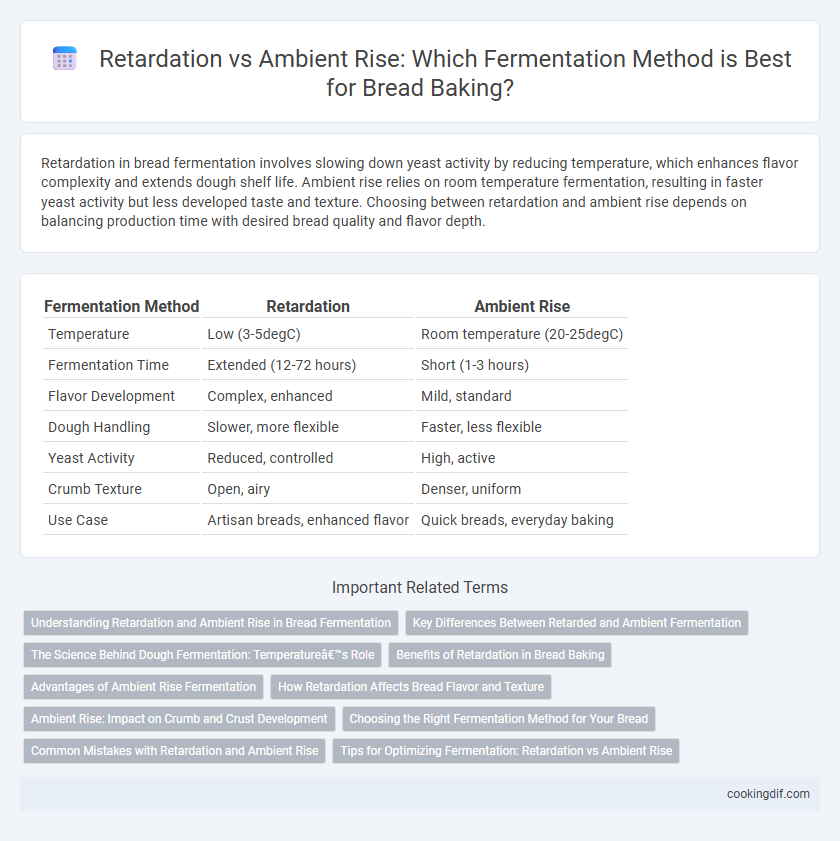Retardation in bread fermentation involves slowing down yeast activity by reducing temperature, which enhances flavor complexity and extends dough shelf life. Ambient rise relies on room temperature fermentation, resulting in faster yeast activity but less developed taste and texture. Choosing between retardation and ambient rise depends on balancing production time with desired bread quality and flavor depth.
Table of Comparison
| Fermentation Method | Retardation | Ambient Rise |
|---|---|---|
| Temperature | Low (3-5degC) | Room temperature (20-25degC) |
| Fermentation Time | Extended (12-72 hours) | Short (1-3 hours) |
| Flavor Development | Complex, enhanced | Mild, standard |
| Dough Handling | Slower, more flexible | Faster, less flexible |
| Yeast Activity | Reduced, controlled | High, active |
| Crumb Texture | Open, airy | Denser, uniform |
| Use Case | Artisan breads, enhanced flavor | Quick breads, everyday baking |
Understanding Retardation and Ambient Rise in Bread Fermentation
Retardation in bread fermentation refers to slowing down yeast activity by placing the dough in a cool environment, typically between 2degC to 8degC, which enhances flavor development and dough extensibility. Ambient rise occurs when dough ferments at room temperature, usually around 20degC to 25degC, leading to faster yeast fermentation and quicker proofing times. Understanding these processes allows bakers to control fermentation speed and optimize texture and aroma in the final bread product.
Key Differences Between Retarded and Ambient Fermentation
Retardation fermentation involves refrigerating the dough to slow yeast activity, enhancing flavor complexity and texture by allowing extended fermentation times, while ambient rise occurs at room temperature, leading to faster proofing but less nuanced taste development. Retarded fermentation maintains dough temperature around 4degC, preserving acidity and producing a chewier crumb, whereas ambient rise often takes place between 20-25degC, resulting in quicker gas production and a softer crumb. This key difference impacts the final bread aroma, crust quality, and shelf life, with retarded fermentation offering greater control for artisan baking.
The Science Behind Dough Fermentation: Temperature’s Role
Retardation slows dough fermentation by refrigerating it at temperatures around 4degC, allowing yeast activity to decrease and flavor compounds to develop over an extended period. Ambient rise occurs at room temperature, typically between 20-25degC, where fermentation happens faster due to increased yeast metabolism, leading to quicker gas production and dough expansion. Temperature directly influences enzymatic reactions and yeast fermentation rates, controlling both the dough's rise time and flavor complexity.
Benefits of Retardation in Bread Baking
Retardation in bread baking involves slowing fermentation by refrigeration, which enhances flavor development through extended enzymatic activity and yeast metabolism. This method improves dough strength and structure, resulting in better crumb texture and shelf life compared to ambient rise fermentation. Retardation also provides greater control over fermentation timing, allowing bakers to optimize workflow and produce consistently high-quality bread.
Advantages of Ambient Rise Fermentation
Ambient rise fermentation accelerates the dough's leavening process by maintaining consistent temperature and humidity, promoting robust yeast activity and enhancing flavor development. This method reduces fermentation time compared to retardation, allowing for faster production cycles and higher bakery throughput. The natural environment during ambient rise also fosters a more complex crumb structure and improved texture in the final bread product.
How Retardation Affects Bread Flavor and Texture
Retardation in bread fermentation slows down yeast activity by chilling the dough, which enhances flavor development through extended enzymatic reactions and yeast fermentation, resulting in more complex, tangy, and nuanced taste profiles. The slower fermentation allows for greater formation of organic acids and alcohols, contributing to depth in flavor and improved crust coloration. Texture benefits include a chewier crumb with better gluten structure and moisture retention, contrasting with quicker ambient rise methods that produce lighter but less flavorful bread.
Ambient Rise: Impact on Crumb and Crust Development
Ambient rise fermentation significantly influences crumb and crust development by allowing a gradual dough expansion at room temperature, enhancing yeast activity and flavor complexity. This slower fermentation process promotes a more open crumb structure with improved moisture retention, leading to a softer texture and richer taste profile. The crust benefits from prolonged enzymatic reactions, resulting in a deeper color and a more pronounced, robust crust flavor.
Choosing the Right Fermentation Method for Your Bread
Retardation fermentation involves slowing yeast activity by refrigerating the dough, enhancing flavor complexity and improving texture through extended fermentation. Ambient rise occurs at room temperature, offering faster proofing but potentially less depth in taste and crumb structure. Selecting the right method depends on your schedule, desired flavor intensity, and texture preferences for optimal bread quality.
Common Mistakes with Retardation and Ambient Rise
Common mistakes with retardation in bread fermentation include underestimating the impact of cold temperatures on yeast activity, resulting in uneven dough rise and poor gluten development. Ambient rise errors often stem from inconsistent room temperatures, causing overproofing or underproofing that affects crumb structure and flavor. Both methods require precise timing and temperature control to ensure optimal fermentation and dough texture.
Tips for Optimizing Fermentation: Retardation vs Ambient Rise
Retardation fermentation involves slowing down yeast activity by refrigerating dough, enhancing flavor development and crumb structure through extended proofing times. Ambient rise fermentation, performed at room temperature, accelerates yeast metabolic activity for faster dough leavening but may sacrifice some flavor complexity. To optimize fermentation, control temperature precisely, monitor dough consistency, and adjust proofing duration based on desired taste and texture outcomes.
Retardation vs Ambient Rise for fermentation Infographic

 cookingdif.com
cookingdif.com